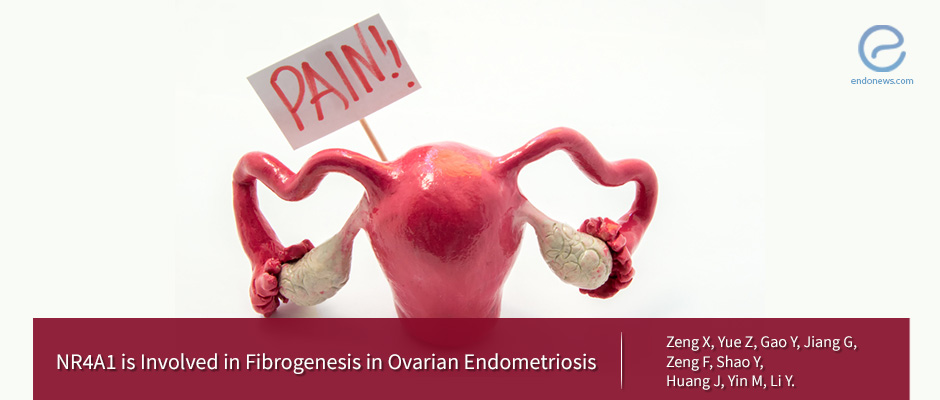New Target for Endometriosis Treatment?
Jun 21, 2018
NR4A1 could be a new therapeutic target for endometriosis, study shows.
Key Points
Highlights:
- The development and progression of endometriosis are linked to fibrosis, which is the formation of scar tissue.
- NR4A1, a receptor protein involved in cell division, inflammation, and programmed cell death, could also be involved in fibrosis in endometriosis and therefore be a novel target for the treatment of the disease.
Importance:
- Although NR4A1 has not directly been linked to fibrosis, it is known to be a strong activator of a biological pathway called the TGF-β signaling pathway, which itself is the most potent promoter of fibrosis.
- A molecule called Csn-B, which activates NR4A1 could serve as a potential new target to block scar tissue formation and the development and progression of endometriosis.
What's done here:
- Researchers analyzed the levels of NR4A1 in endometrial tissue from women with and without endometriosis.
- They also blocked or induced the activity of NR4A1 in the laboratory and in mouse models to further test the potential role of this protein in endometriosis fibrosis.
Key results:
- Levels of phosphorylated NR4A1 were higher in ovarian endometriotic tissue compared to the normal endometrium, reflecting the potential role of the molecule in endometriosis.
- Experimentally blocking the activity of NR4A1 in human endometrial cells led to the production of TGF-β1-induced fibrotic markers
- Csn-B, which activates NR4A1 decreased the levels of markers of fibrosis in human endometrial cells.
- In mice without NR4A1 protein, fibrosis progressed faster.
- Treating mice with endometriosis with Csn-B suppressed fibrosis.
Limitations:
- The experiments were conducted in the laboratory and using mouse models of endometriosis. Further research is needed to fully identify the potential role of NR4A1 and Csn-B in treating endometriosis.
- The current study only focuses on the role of fibrosis in endometriosis. However, fibrosis is not the sole determinant of the disease, which is complex and involves many biological pathways. The effectiveness of targeting Csn-B may, therefore, be limited or temporary in treating endometriosis.
Lay Summary
NR4A1 could be a novel target for the treatment of endometriosis, according to a study published in the scientific journal Cell Physiology and Biochemistry. NR4A1 is a receptor protein involved in cell division, inflammation, and programmed cell death.
The development and progression of endometriosis have been linked to fibrosis or the formation of scar tissue, causing chronic pelvic pain and infertility in women affected by this disease. Transforming growth factor-β (TGF-β) is the most potent promoter of fibrosis and is thought to be involved in endometriosis. Although the role of NR4A1 in endometriosis had not been studied so far, previous research has shown that NR4A1 is a strong and important activator of the TGF-β signaling pathway.
In order to decipher the potential role of NR4A1 in endometriosis-associated fibrosis and the related symptoms of the conditions, a team of researchers in China analyzed the levels of NR4A1 in endometrial tissue from women with and without endometriosis. They also conducted a number of experiments in the laboratory and using mice models of endometriosis to further test the hypothesis that NR4A1 could be involved in fibrosis in endometriosis.
They found that levels of phosphorylated NR4A1 were higher in ovarian endometriotic tissue compared to normal endometrium. Phosphorylation or the addition of a phosphate group to a protein is a chemical modification that activates, inactivates, or modifies the function of that protein.
Researchers also found that experimentally blocking the activity of NR4A1 in human endometrial cells led to the production of TGF-β1-induced fibrotic markers, or proteins associated with scar tissue formation. Conversely, cytosporone B or Csn-B, a molecule that activated NR4A1 decreased the levels of fibrotic markers.
Finally, they found that in genetically modified mice that did not have NR4A1 protein fibrosis progressed faster, and in mice in which endometriosis was induced, treatment with Csn-B suppressed the formation of scar tissue.
Together these findings led the researchers to conclude that NR4A1 may be involved in the fibrosis of ovarian endometriosis and could be a novel target for the treatment of this disease. They proposed that Csn-B could be a potential therapeutic candidate.
Research Source: https://www.ncbi.nlm.nih.gov/pubmed/29669342
endometriosis NR4A1 fibrosis Csn-B mouse model treatment inflammation apoptosis TGF-beta treatment

